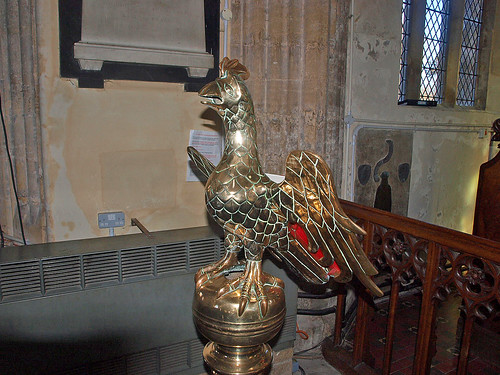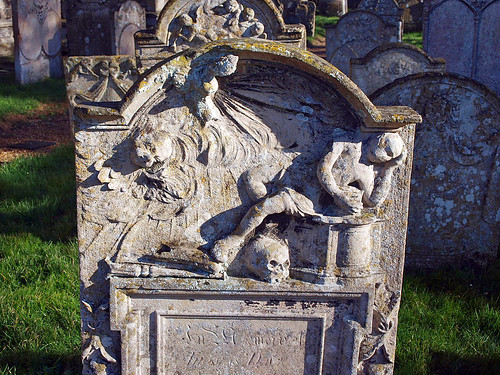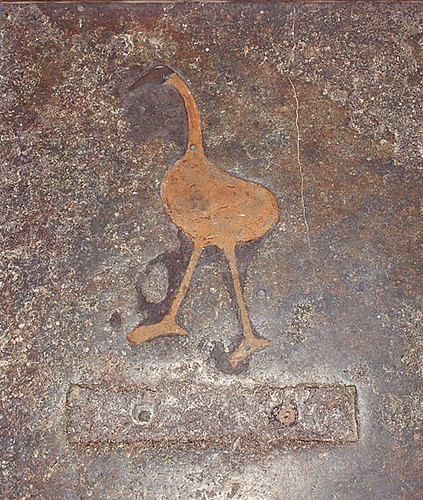ST PETER. Of Barnack stone and ragstone, mostly Perp and embattled. E. E. NW tower. Two-light bell-openings with a dividing round shaft and pierced trefoils in the spandrels. The top storey is octagonal and Perp. The tower arch to the E is a powerful piece and shows that the C13 church lay where the N aisle now is. However, by about 1300 the present nave had been begun. Its W doorway and W window (cusped intersected tracery; renewed) show that. Embattled Perp aisles. Perp also the tall arch from the tower into the nave. Perp clerestory, and at its SE end a very pretty brick turret with a top for the sanctus bell. Two-storeyed,Perp N porch with a tierceron-vault inside. The centre is a figure of four ogee leaves. The upper porch window is straight-headed. Long chancel with C19 E window. Perp five-bay arcades. Slender piers without any capitals except for the thin shafts towards the arches. The chancel arch, nearly straight-sided, has the same type of mouldings. The church still has its early C19 W and N galleries, a rare survival. Nave roof with alternating tie-beams and hammerbeams, the latter with angels with spread wings. The aisle roofs also with hammerbeams and also with angels; quite splendid. - FONT. Octagonal, Perp, with demi-figures of angels holding shields. - LECTERN. C15, of brass, East Anglian, of the same type as the lecterns at Woolpit and Cavendish in Suffolk, Chipping Campden in Gloucestershire, Corpus Christi College at Oxford, and Crofts in Lincolnshire. - ROYAL ARMS. Splendidly carved. - PLATE. Cup and Paten, 1629; Flagon, 1639; Almsdish, 1770. - MONUMENTS. Two early C15 brasses to priests, one with a 3 ft 10 in. figure under a tripartite canopy, the other a 2 ft 6 in. figure. They commemorate William Mowbray d 1428 (chancel S) and Henry Martyn d 1435 (chancel N). - In the churchyard many carved headstones. The churchyard GATES with fine large gateposts and iron gates; C18.
UPWELL. The River Nene comes here from Cambridgeshire into Norfolk, and the pleasant old houses and the cottages make most of it, disposing themselves in a long broken line on each side of the slow-moving stream. At the Outwell end of the village is a windmill, the two neighbours making together perhaps the longest village in the land, spreading for nearly five miles.
In the heyday of Upwell’s prosperity, when it was a market town, the big church of St Peter was built by the river, and its square tower with the octagonal top, standing among the trees and looking down on orchards, has been since the 13th century the symbol of steadfastness among changing fortunes.
Gates of delicately wrought iron lead to the church, which is for the most part 200 years younger than the tower. The fine porch has a vaulted roof supporting an upper room, and the lovely door letting us in has traceried panels and a border with 16 pelicans. The beauty inside is marred by galleries and the crowd of pews, though the odd block of seats for two down the middle of the nave, between the high shut-in pews, is quaint and unusual. About 25 oak angels with outspread wings look down from the striking old roofs of the nave and aisles, which have richly carved beams and angels on the borders. The chancel roof has hammerbeams and saints. The canopied sedilia are carved with tracery, the font has angels holding shields, and part of a coffin stone is in the wall. One of the oldest of about 50 old brass eagles left in England is the 14th-century lectern; it has a comb like a cock, and three lions at the foot.
There are brass portraits of 500 years ago, one big and one small, of two priests in their copes. A brass plate of 1621 is engraved with kneeling figures of Jane and Linolphus Bell and their 11 children, the boys in cloaks, the girls in bonnets and ruffs. An inscription recording the outbreak of cholera last century when 67 people died in a few weeks ends with a moral question: Reader, why hast thou been spared? To what purpose hast thou been left until now?
Upwell’s peace memorial window has figures of St George, St Michael, and St Nicholas, and scenes of the Crucifixion, three soldiers by the trenches, and three sailors by the sea.
In the heyday of Upwell’s prosperity, when it was a market town, the big church of St Peter was built by the river, and its square tower with the octagonal top, standing among the trees and looking down on orchards, has been since the 13th century the symbol of steadfastness among changing fortunes.
Gates of delicately wrought iron lead to the church, which is for the most part 200 years younger than the tower. The fine porch has a vaulted roof supporting an upper room, and the lovely door letting us in has traceried panels and a border with 16 pelicans. The beauty inside is marred by galleries and the crowd of pews, though the odd block of seats for two down the middle of the nave, between the high shut-in pews, is quaint and unusual. About 25 oak angels with outspread wings look down from the striking old roofs of the nave and aisles, which have richly carved beams and angels on the borders. The chancel roof has hammerbeams and saints. The canopied sedilia are carved with tracery, the font has angels holding shields, and part of a coffin stone is in the wall. One of the oldest of about 50 old brass eagles left in England is the 14th-century lectern; it has a comb like a cock, and three lions at the foot.
There are brass portraits of 500 years ago, one big and one small, of two priests in their copes. A brass plate of 1621 is engraved with kneeling figures of Jane and Linolphus Bell and their 11 children, the boys in cloaks, the girls in bonnets and ruffs. An inscription recording the outbreak of cholera last century when 67 people died in a few weeks ends with a moral question: Reader, why hast thou been spared? To what purpose hast thou been left until now?
Upwell’s peace memorial window has figures of St George, St Michael, and St Nicholas, and scenes of the Crucifixion, three soldiers by the trenches, and three sailors by the sea.



No comments:
Post a Comment